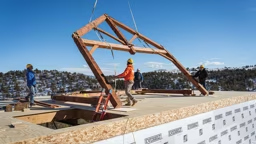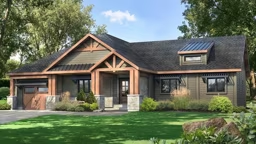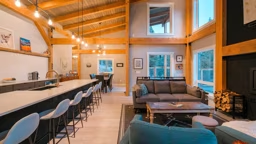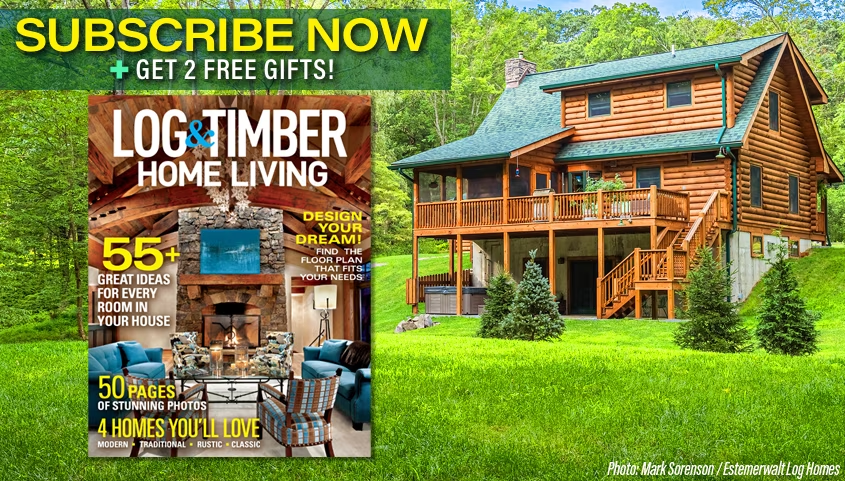
As with most things in the custom-home-building process, the first things you need to consider are your wants, needs and how much of your budget you’re planning to invest in those areas. Kitchens, baths and bedrooms are obviously all “needs,” but the design and materials you select to outfit those spaces are driven by your “wants.”
Beyond this wish list, there’s another factor to the equation: ROI. Building a log or timber home is a huge investment. If it’s a forever home (the last house you plan to purchase) or a legacy home (one you’ll pass down through the generations), your approach may be quite different than if it’s an investment home (one you plan to sell for a profit one day). In other words, some amenities and upgrades may have personal ROI, but may not translate to a financial return on your investment, if you decide to sell.
So if you’re striving to find that balance between economy and enjoyment, determine an amenity’s value by comparing how it will impact your quality of life against the cost investment you make in it.
The good news is that there are several key areas where investing your budget will achieve both a real and perceived ROI. Here’s where I think your hard-earned dollars should go:
Preservatives
You love log and timber homes. If you didn’t, you wouldn’t be reading our magazine. These wood components are not only the focus of these homes, but also are the largest “hit” to the budget. Therefore, treating them with a high-quality preservative has to be a top priority. It adds both beauty and longevity to the home; it keeps the value of your home high; and it reduces your maintenance expense over time.
Windows
Windows impact both the exterior and interior look of the home, its energy efficiency and your personal comfort level. Designing an abundance of windows and allowing natural light to penetrate your rooms will make them feel more spacious, boost your passive-solar-heat gain and enhance your enjoyment by allowing you to capture gorgeous views. Plus, buying and installing “glazing,” as it’s called, into a wall costs roughly the same per square foot as logs do, so not only is the expense basically a wash, it’s value you can recoup in resale. For all these reasons, buying the best windows you can is never a bad investment.
Kitchens
If you’re someone who loves to cook, then you’ll likely gravitate toward higher-end kitchen fixtures, such as top-of-the-line appliances, luxe-looking quartz countertops and ample cabinetry. Of course, all of these extras come with bigger price tags, but if you use them multiple times daily, the cost-per-use comes down significantly, giving you a better ROI and supporting your lifestyle.
If you’re not an entertainer or you eat out five times a week, the kitchen can be an ideal place to shave and save. Design it so you still have a high level of functionality, but not to full-blown gourmet grade, because even if you plan to sell this house one day, you likely won’t get all of your investment back. Gourmet-style kitchens can cost 15 to 20 percent of your whole house budget — just in that one room. A nicely appointed but budget-conscious kitchen will serve you better.
Bathrooms
Here, the best use of money is simple: enlarge your shower space and eliminate the curb (the lip you step over to enter it). I recommend a minimum of 42-by-72 inches. As something you use every day, you’ll really appreciate these upgrades as you age.
What shouldn’t you spend money on? A “wet room.” While this concept of a wide-open, all-in-one standing shower and freestanding tub is trending — and looks cool on social media and TV — it doesn’t retain heat or steam. So, your shower ends up feeling drafty, and water sprays everywhere. Plus, they can be a nightmare to keep clean. Don’t fall for the hype.
Fireplaces
Having a fireplace in a log or timber frame home is a natural fit, and I’m not suggesting you nix it. However, I do believe you have excellent options other than a masonry fireplace, which typically is not only a building-budget buster, it’s also an energy vampire after construction is complete. Not only that, maintaining it is a heavy lift.
For years I’ve been a proponent of vent-free gas units. If you’re building in a colder climate like the Northeast or upper Midwest, a fireplace is something you’d use as a heat source and going vent-free lets you to capture 100 percent of the usable energy. That’s your best return on investment.
However, if you live in the South where it’s occasionally chilly and a fireplace is used for ambiance more than heat, look to an electric fireplace. I have one, myself, and trust me — these appliances have come a long way with LED light technology, offering colorful, realistic flames, glowing embers and even the crackle of burning wood. They also throw an impressive amount of heat when you need it and (bonus) are heat-free when you don’t. So you can enjoy the fire’s soft glow, no matter the weather. Combine these benefits with solar technology, and you can enjoy a fire without fossil fuels.
Spend on This, Not That
Believe it or not, one in 11 U.S. citizens rents an external storage facility according to governing.com, a news analysis site. We all have “stuff” we need to store, but did you know putting $100 toward your monthly mortgage versus $100 per month on a mini-storage unit allows you to add an average of 400 to 500 square feet to your home? Would you rather pay for someone else’s square footage or your own? Redistribute those funds to a bonus storage loft above the garage or a walk-in pantry.
Dan Mitchell is a builder and a log and timber home educator. He owns Eagle CDI, a construction and development firm based near Knoxville, Tennessee.











